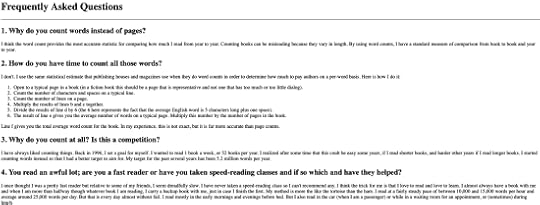The Old Web
Every now and then, I come across a website that reminds me of the early days of the Internet. Take, for example, the computer science professors Brian Kernighan and Donald Knuth. Kernighan’s site is a little more elaborate than Knuth’s. For those who remember the early days of the Internet, Knuth’s site looks pretty close, but both remind me of the old days.
There is a delightful simplicity to early web pages that I miss in the modern web. Information was made available with the barest formatting. You had headers and bullets and simple, often clunky-looking tables. You could insert images if you wanted.
There is a parallel, I think, between the old web and old word processors. WordPerfect and Microsoft Word for DOS 5.5 (the latter was my personal favorite) had text-only displays that allowed you to focus on what you were writing. There was no WYSIWYG to distract you. More time was spent writing because less time was spent fidgeting with the presentation. Indeed, this was part of the reason the schools and publishers had simple formatting guidelines: 1-inch margins, double-spaced text, etc. It was not a writer’s job to worry about presentation.
When I come across an old-style web page, I feel a sudden sense of envy. I feel like I want to throw off the shackles of style and CSS and just present the text in its rawest form. The old web had its own built-in style and that seemed more than enough at the time. Formatting was an afterthought, unless it was the infamous tag that made text flash annoyingly on the screen. You went to a web page to read the text, not to be dazzled by the design. It reminds me of those bullet journals that look like works of art versus the ones that are messy scribbles on a page. The works of art are a joy to look at, but I often wonder how practical they are to maintain.
The first web pages I put on the public Internet were also of the simplest formatting. Of course, they were all about books and reading. I found a couple of examples on the Wayback Machine, including a page on my favorite science fiction writers of the time (circa 2003) and an FAQ on my reading list. (Naturally, the list of books I’ve read since 1996 was one of the first things I put on the web.)
 An FAQ from my website, circa 2003.
An FAQ from my website, circa 2003.My first experience with the Internet, outside the walled garden of AOL, was in 1994 when I started with my company. That was more than 30 years ago, and it occurs to me that there are people reading this piece who were not alive at the time and have no frame of reference to those early days. Reddit might look antiquated from that perspective, but I recall fondly the joys of Usenet, especially its simple, plaintext look-and-feel. I enjoy browsing sites like textfiles.com now and then as a form of digital nostalgia, but also as a reminder that writing on the Internet does not have to be as complex as we make it.
Of course, once one website gets a facelift, others follow, each seeking to get the most possible attention in a world where free time and attention are at a premium. I am no different in this regard. While I wouldn’t consider my website a trendsetter in terms of style, neither is it the basic HTML formatting of the early Internet. As much as I’d like it to be, I don’t think most readers these days would tolerate that. We’ve been trained to expect more from style, even as we expect less from content.
Post Scripts
I wrote two drafts of this post. I’m not particularly pleased with either, but whatever you think of what I finally published, it is better than the first draft. This is what happens when I try to post every day and lose some of my lead time to laziness and life in general. On the other hand, it helps me better understand the pressure a sportswriter is under to get a column out or to write an original summary of a ball game 162 times a season.Did you enjoy this post?
If so, consider subscribing to the blog using the form below or clicking on the button below to follow the blog. And consider telling a friend about it. Already a reader or subscriber to the blog? Thanks for reading!



